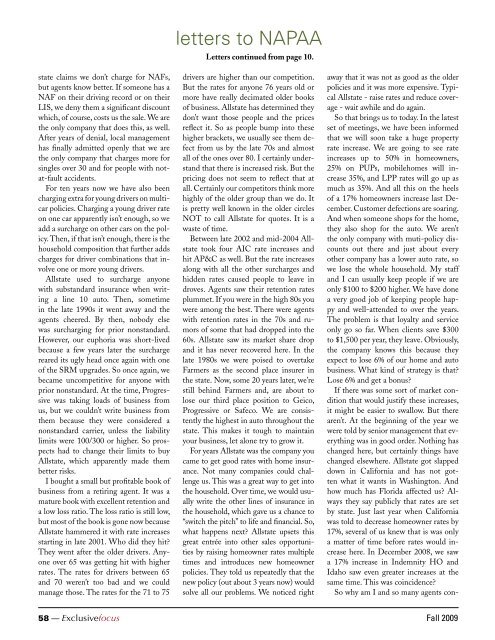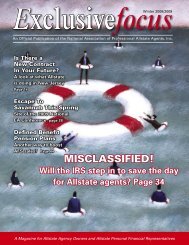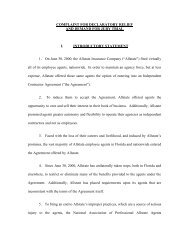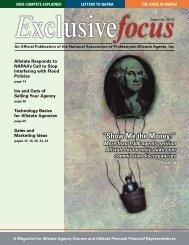A CALL TO ARMS - National Association of Professional Allstate ...
A CALL TO ARMS - National Association of Professional Allstate ...
A CALL TO ARMS - National Association of Professional Allstate ...
- No tags were found...
You also want an ePaper? Increase the reach of your titles
YUMPU automatically turns print PDFs into web optimized ePapers that Google loves.
state claims we don’t charge for NAFs,but agents know better. If someone has aNAF on their driving record or on theirLIS, we deny them a significant discountwhich, <strong>of</strong> course, costs us the sale. We arethe only company that does this, as well.After years <strong>of</strong> denial, local managementhas finally admitted openly that we arethe only company that charges more forsingles over 30 and for people with notat-faultaccidents.For ten years now we have also beencharging extra for young drivers on multicarpolicies. Charging a young driver rateon one car apparently isn’t enough, so weadd a surcharge on other cars on the policy.Then, if that isn’t enough, there is thehousehold composition that further addscharges for driver combinations that involveone or more young drivers.<strong>Allstate</strong> used to surcharge anyonewith substandard insurance when writinga line 10 auto. Then, sometimein the late 1990s it went away and theagents cheered. By then, nobody elsewas surcharging for prior nonstandard.However, our euphoria was short-livedbecause a few years later the surchargereared its ugly head once again with one<strong>of</strong> the SRM upgrades. So once again, webecame uncompetitive for anyone withprior nonstandard. At the time, Progressivewas taking loads <strong>of</strong> business fromus, but we couldn’t write business fromthem because they were considered anonstandard carrier, unless the liabilitylimits were 100/300 or higher. So prospectshad to change their limits to buy<strong>Allstate</strong>, which apparently made thembetter risks.I bought a small but pr<strong>of</strong>itable book <strong>of</strong>business from a retiring agent. It was amature book with excellent retention anda low loss ratio. The loss ratio is still low,but most <strong>of</strong> the book is gone now because<strong>Allstate</strong> hammered it with rate increasesstarting in late 2001. Who did they hit?They went after the older drivers. Anyoneover 65 was getting hit with higherrates. The rates for drivers between 65and 70 weren’t too bad and we couldmanage those. The rates for the 71 to 75letters to NAPAALetters continued from page 10.drivers are higher than our competition.But the rates for anyone 76 years old ormore have really decimated older books<strong>of</strong> business. <strong>Allstate</strong> has determined theydon’t want those people and the pricesreflect it. So as people bump into thesehigher brackets, we usually see them defectfrom us by the late 70s and almostall <strong>of</strong> the ones over 80. I certainly understandthat there is increased risk. But thepricing does not seem to reflect that atall. Certainly our competitors think morehighly <strong>of</strong> the older group than we do. Itis pretty well known in the older circlesNOT to call <strong>Allstate</strong> for quotes. It is awaste <strong>of</strong> time.Between late 2002 and mid-2004 <strong>Allstate</strong>took four AIC rate increases andhit AP&C as well. But the rate increasesalong with all the other surcharges andhidden rates caused people to leave indroves. Agents saw their retention ratesplummet. If you were in the high 80s youwere among the best. There were agentswith retention rates in the 70s and rumors<strong>of</strong> some that had dropped into the60s. <strong>Allstate</strong> saw its market share dropand it has never recovered here. In thelate 1980s we were poised to overtakeFarmers as the second place insurer inthe state. Now, some 20 years later, we’restill behind Farmers and, are about tolose our third place position to Geico,Progressive or Safeco. We are consistentlythe highest in auto throughout thestate. This makes it tough to maintainyour business, let alone try to grow it.For years <strong>Allstate</strong> was the company youcame to get good rates with home insurance.Not many companies could challengeus. This was a great way to get intothe household. Over time, we would usuallywrite the other lines <strong>of</strong> insurance inthe household, which gave us a chance to“switch the pitch” to life and financial. So,what happens next? <strong>Allstate</strong> upsets thisgreat entrée into other sales opportunitiesby raising homeowner rates multipletimes and introduces new homeownerpolicies. They told us repeatedly that thenew policy (out about 3 years now) wouldsolve all our problems. We noticed rightaway that it was not as good as the olderpolicies and it was more expensive. Typical<strong>Allstate</strong> - raise rates and reduce coverage- wait awhile and do again.So that brings us to today. In the latestset <strong>of</strong> meetings, we have been informedthat we will soon take a huge propertyrate increase. We are going to see rateincreases up to 50% in homeowners,25% on PUPs, mobilehomes will increase35%, and LPP rates will go up asmuch as 35%. And all this on the heels<strong>of</strong> a 17% homeowners increase last December.Customer defections are soaring.And when someone shops for the home,they also shop for the auto. We aren’tthe only company with muti-policy discountsout there and just about everyother company has a lower auto rate, sowe lose the whole household. My staffand I can usually keep people if we areonly $100 to $200 higher. We have donea very good job <strong>of</strong> keeping people happyand well-attended to over the years.The problem is that loyalty and serviceonly go so far. When clients save $300to $1,500 per year, they leave. Obviously,the company knows this because theyexpect to lose 6% <strong>of</strong> our home and autobusiness. What kind <strong>of</strong> strategy is that?Lose 6% and get a bonus?If there was some sort <strong>of</strong> market conditionthat would justify these increases,it might be easier to swallow. But therearen’t. At the beginning <strong>of</strong> the year wewere told by senior management that everythingwas in good order. Nothing haschanged here, but certainly things havechanged elsewhere. <strong>Allstate</strong> got slappeddown in California and has not gottenwhat it wants in Washington. Andhow much has Florida affected us? Alwaysthey say publicly that rates are setby state. Just last year when Californiawas told to decrease homeowner rates by17%, several <strong>of</strong> us knew that is was onlya matter <strong>of</strong> time before rates would increasehere. In December 2008, we sawa 17% increase in Indemnity HO andIdaho saw even greater increases at thesame time. This was coincidence?So why am I and so many agents con-58 — Exclusivefocus Fall 2009
















